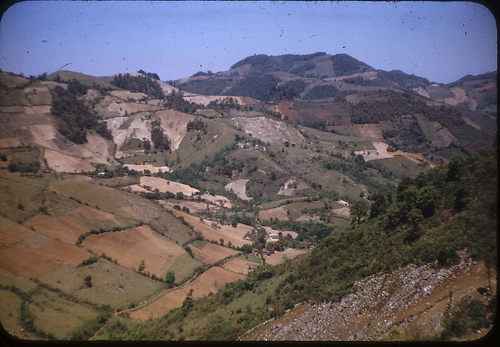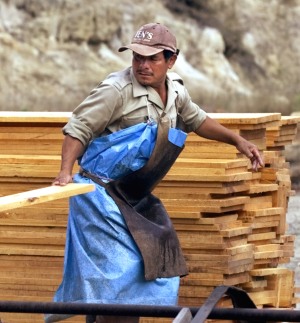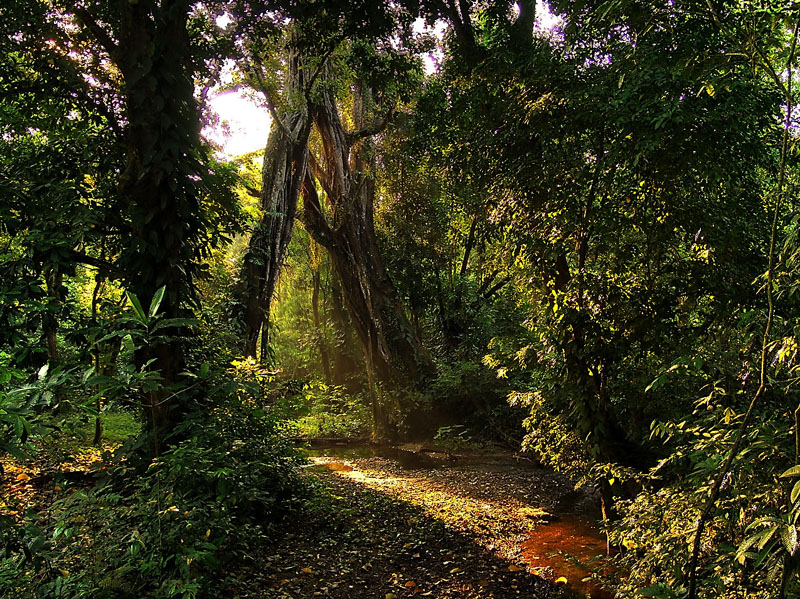Activity page

Workshop on Sustainable Productive Forest Landscapes in Mexico
CHALLENGE
The Government of Mexico has recently approved an ambitious Plan (PRONAFOR 2014-2018) with a vision to transform the forest sector into a competitive and socially-inclusive sector that would boost rural economy in Mexico. To achieve its objectives the PRONAFOR is based on a transversal approach, which contemplates the collaboration and coordination of its activities with a number of other government entities, including the Ministry of Agriculture. However, the multiplicity of government actors operating in the rural sector in Mexico under a set of dispersed and fragmented functions makes the necessary inter-sectoral coordination mechanisms difficult to materialize at the operational level, since experience with such mechanisms is scarce. Disseminating information and learning from the experience of successful models that have achieved territorial integration both within Mexico and abroad, will be important in order to promote the landscape approach envisioned by PRONAFOR.
APPROACH
The main objective of this activity is to equip stakeholders with information and good practices for handling challenges and opportunities to implementing a multi-sectoral and inter-institutional landscape approach. This will be done by creating a space for multi-stakeholder dialogue and analysis around the challenges and opportunities for the implementation of PRONAFOR’s landscape approach. In particular, a workshop will be coordinated and focus on the multi-sectoral and inter-institutional coordination mechanisms that are required in order to allow for the implementation of the different sectoral programs in an integrated manner at the territorial level.
RESULTS
The forum, held April 7-8, 2015, in Mexico City, gathered decision makers from the various sector administrations (agriculture, forest, finance) and levels of government (federal, state, local), as well as representatives from the civil society and the private sector. Three international experts were invited to present different experiences related to sustainable productive landscapes and to share successful experiences and knowledge focusing mainly on how different sectors interact in the territory and how different activities may be aligned in order to promote sustainable and integrated rural development. In total, 50 people attended the forum.
The report “Modelo de Intervención en las Áreas de Acción Temprana REDD+” was distributed by the National Commission on Forests (CONAFOR) in advance of the forum, guided the discussions during the two-day forum.
As a result of the forum, CONAFOR and the Ministry of Agriculture (SAGARPA) agreed on a road map (ruta crítica) to enhance collaboration both at the federal and local levels. Minutes of the forum (including the road map) were published on CONAFOR’s website. Further dissemination was done (by CONAFOR and the Bank – see the blog “Many challenges – Many rewards: working together to strengthen forest sector in Mexico”.
For stories and updates on related activities, follow us on twitter and facebook , or subscribe to our mailing list for regular updates.
Last Updated : 06-16-2024

Share
Attachments
RainforestAlliance_Honduras_English_0.pdf
Keywords
Authors/Partners
Rainforest Alliance
Strengthening the Value Chain for Indigenous and Community Forestry Operations
Strengthening the value chain for indigenous and community forestry operations through increased investment and use of technical assistance
CHALLENGE
Spanish versions of the three case studies:
|
The link between sustainable forest management practices and community benefits has not been well documented. Likewise, the connection between the sale of certified products and conservation outcomes is sometimes lost amid general skepticism. Part of the reason investments in community forestry operations are not well understood is that studies tend to rely on anecdotal evidence rather than income and productivity data.
APPROACH
Building on the successful work of the Rainforest Alliance's Sustainable Forestry Division in Mexico and Central America, PROFOR co-financed three case studies documenting changes in income, return on investment and the role of technical assistance in bringing investments to their full potential in Mexico, Guatemala and Honduras.
The case studies are expected to motivate community forestry operations to invest in their operations and strive for improved competitiveness.
MAIN FINDINGS
- In Mexico, with an investment of $1.1 million over three years, the operation increased sawmilling efficiencies and lowered production costs by 43% without sacrificing jobs. A greater focus on secondary processing and investment in their business led to a change in annual profits from minus $561,646 to plus $1.7 million.
- In Guatemala, FSC certified community concessions increased their revenues by 209% to $5.8 million. Improved saw milling efficiencies and higher grades of mahogany along with FSC certified mahogany price increases drove the increase in revenues as did the addition of a FSC certified non-timber product. Employment increased for women though value added processing for non-timber products. Investments by communities themselves have been modest but donor investments in training and technical assistance have probably exceeded $10 million.
- In Honduras, cooperatives banded together to provide semi-processed mahogany for export to certified markets, changing their production chain and adopting sustainable forest management practices. With only a 19% increase in volume harvested, revenues have increased by 128% to $579,375. Actual production costs rose 40% from 2006 to 2008, due to increased costs of forest management and taxes, as well as the extra care needed to produce quality mahogany grades. The cooperatives have invested over $113,000 in simple machinery.
RESULTS
The results of the three case studies were presented at the World Forestry Congress in Buenos Aires, Argentina in October 2009. The Mexico case study was presented at the Expo Forestal in Mexico in September 2009. In both cases, the data on production, efficiency and community benefits was well received.
The indicators used in these cases studies will be useful for measuring impact in other communities. A new forestry project with CONAFOR/UNDP/GEF and the Rainforest Alliance will use the same methodology and variables in Mexico to measure community level impacts on wood harvesting, usage and income. The Rainforest Alliance is also starting two new community forestry projects in Ghana and Cameroon which will use a subset of these variables, adapted for West Africa.
For stories and updates on related activities, follow us on twitter and facebook , or subscribe to our mailing list for regular updates.
Author : Rainforest Alliance
Last Updated : 06-16-2024
Share
Keywords
Authors/Partners
World Bank Latin America and Caribbean Region, CONAFOR
Redesigning the Mexican Forest Fund to support sustainable forest management
BACKGROUND
The Government of Mexico recognizes the critical importance of forests as a natural asset for domestic socio-economic development as well as for the environmental services they provide. The Government’s commitment to this agenda is evidenced by its participation in relevant international fora, such as President Calderon’s statements on REDD+ at COP 16 in Cancun, Mexico’s leading role in the Forest Carbon Partnership Facility, and a new partnership with Costa Rica and Ecuador to learn lessons about how Payment for Environmental Services programs in those countries can create conditions for future REDD+ implementation.
CONAFOR (Comisión Nacional Forestal) was created as a decentralized agency by decree in 2001 with the objective of developing, supporting, and encouraging productive activities related to conservation and forest restoration, and of applying the policy of sustainable forest development. To that end, CONAFOR’s main financial instrument is the Forest Fund which:
- facilitates access to financial services
- promotes projects to integrate and increase the competitiveness of production chains
- develops mechanisms for payment of environmental services
- promotes bonds associated with the conservation of forest resources
- and also channels direct subsidy payments to communities to support activities such as reforestation, soil conservation, community forest management, and payments for environmental services.
CHALLENGE
The size of the Forest Fund and the scale of its operations have grown tremendously since its inception in 2001. The number of transactions has increased from about 200 per year to about 12,000 and the size of the fund has grown from about 20 to 600 million dollars. Also, some additional financial mechanisms have been created linked to the Forest Fund, such as a guarantee fund for forest plantations. In addition, it is expected that the Forest Fund will play an enabling role as part of the financial architecture that will be used to manage new financing associated with REDD+.
APPROACH
In light of Mexico’s changing circumstances and needs, CONAFOR and the World Bank proposed in 2011 to collaborate to redesign the Forest Fund so that it becomes a state-of-the art, best-practice financial mechanism, by:
- identifying key desirable features in the Forest Fund emerging from the current climate discussions and current and future needs,
- identifying international good practices relevant to Mexico’s needs (this desk review would build on previous work supported by the UNFF and its Ad-Hoc Expert Group on Forest Finance, and work on national forest financing strategies supported by Tropenbos, the NFP Facility, as well as others)
- providing summary recommendations and options for the redesign of the Fund that are feasible in the Mexican legal context.
RESULTS
This activity was closed in April 2012 because of lack of progress with the proposed analytical and policy support. However the redesign of the Mexican Forest Fund is underway.
For stories and updates on related activities, follow us on twitter and facebook , or subscribe to our mailing list for regular updates.
Author : World Bank Latin America and Caribbean Region, CONAFOR
Last Updated : 06-16-2024
Share
Related Links
ESMAP's Low Carbon Development Country Studies
External Related Links
Brazil Can Take the Lead in Green Growth, says World Bank (feature story, June 28, 2010)
Keywords
Authors/Partners
Energy Sector Management Assistance Program ESMAP
The Role of Forestry in Low-carbon Growth Strategies
CHALLENGE
Many developing countries are proactively seeking to identify opportunities and related financial, technical, and policy requirements to move towards "green growth" on a low-carbon path. With the support of ESMAP, the multi-donor Enegery Sector Management Assistance Program hosted at the World Bank, selected pilot countries have initiated country-specific studies to assess their development goals and priorities, in conjunction with GHG mitigation opportunities, and examine the additional costs and benefits of lower carbon growth. For some of these pilot countries, addressing issues in the forest and land-use sector play an important role for developing low-carbon growth strategies. Because results have been provided until now in an aggregate manner, a detailed analysis of the forestry and land-use sector have not been separately presented. However, such an analysis would provide important information and guidance to develop low-carbon growth strategies for many other countries where forestry and land-use change are key GHG emissions sources. Such knowledge will be especially important for guiding work in developing countries financed by the World Bank, one of the most important implementing institutions of new programs promoting sustainable forest management for GHG mitigation (FCPF, FIP, BioCF, UN-REDD, etc.)
APPROACH
PROFOR will finance ESMAP's effort to produce a policy brief analyzing the role of forests and forest management for developing and implementing low-carbon growth strategies, including financing options related to low-carbon growth. While the policy brief will build on experience and data analyses already undertaken in key pilot countries (Mexico, Indonesia, Brazil), they will provide general guidance on the integration of forestry in low-carbon growth strategies beyond the case study examples.
The policy brief is expected to serve decision makers and World Bank operations "task team leaders" in developing and implementing forestry-based low-carbon growth strategies for countries with significant GHG emissions from the forestry sector.
RESULTS
This activity is ongoing. Results will be shared on this page when they become available.
For stories and updates on related activities, follow us on twitter and facebook , or subscribe to our mailing list for regular updates.
Author : Energy Sector Management Assistance Program ESMAP
Last Updated : 06-16-2024

Share
Related Links
Payments for environmental services supported social capital while increasing land management
Keywords
Authors/Partners
Department of Applied Economics, Oregon State University; Economics Department, Environmental Studies Affiliate, Amherst College; c Development Research Group, The World Bank; and Evaluation Department, National Forestry Commission of Mexico
Evaluating Mexico’s Payment for Environmental Services Scheme
CHALLENGE
Between 1990 and 2010, Mexico lost 5.5 million hectares (or 7.8 percent) of its forest cover (FAO 2010). Deforestation is largely driven by the conversion of forests to croplands or pasture. In response, Mexico’s National Forestry Commission (CONAFOR) introduced its first program of payments for ecosystem services (PES) in 2003. The program encourages forest conservation by making payments to owners of ecologically valuable land. The program has grown substantially since its inception, encompassing 2.5 million hectares of forests as of the end of 2013, making it by far the largest PES program in Latin America. This activity is the first attempt at applying rigorous evaluation methods to a large-scale PES program, to extract valuable lessons learned for similar programs elsewhere. Mexico is planning to make PES a central tool in its strategy for implementing REDD+ and other carbon funds, so a better understanding of the impact of the current program on deforestation is critical.
APPROACH
- The use of payments differentiated by land cover type and economic pressure to deforest, in an effort to attract lands with greater potential environmental benefits;
- Longer-term environmental impacts as a result of participant behavior, including whether applicants re-apply and what their behavior is upon exiting voluntarily or being rejected upon reapplication;
- Whether enrolling forest land lead to deforestation in other, non-enrolled areas;
- The impacts on social capital, especially in regard to the program component that encourages communities to organize themselves in groups in order to better administer forests;
- Household socioeconomic impacts, and whether the program reduces agricultural or pastoral development and incomes as land is committed to conservation uses;
- Whether households and communities are willing to accept contracts with different payment levels.
RESULTS
The study found causal evidence of program effectiveness for this large-scale, government-run program. Looking at an index of community land management activities, communities involved in the program increased their participation by over 50%, protecting land cover by patrolling for illegal conversion, building fire breaks, or combatting soil erosion. Compared to control households, participant households spent approximately 2.7 days more per year in land management activities.
Estimated impacts were small and not statistically significant for changes in average household assets, housing stock, food consumption, and primary education. However, they there was a statistically significant increase of 20-25% in community infrastructure, and a substantive 30-40% increase in school attendance by 16-18-year-olds.
The program’s conditional payments have maintained or made modest improvements in pro-social work effort and measures of social capital at the communal and household level, including measures of institutions, attitudes and participation in community governance. Across all cohorts, the study finds a significant increase of approximately 8% in an index of community social capital, compared to controls. Additional time spent in land management activities does not crowd out other community work by households. Household-level measures of trust and participation are not changed by the program.
Due to data limitations and the overall low rates of forest cover change during the study period, it was difficult to detect anything except a 100% impact by the program. Drawing on the only published data source with annual variation, the analysis suggests that the program has likely reduced the rate of tree cover loss. Within areas at high risk of deforestation, the program reduced the loss of tree cover by approximately 40%. Larger reductions of land cover change were observed in the Yucatan peninsula. Although imprecise, estimates of the percentage change in loss rates are similar in magnitude to prior studies, which found changes between 20-50% depending on the method used.
This study illustrated that an impact evaluation based on causal analysis is possible, and most importantly, research can be done for large-scale government-run programs. With the expansion of climate change initiatives, it is key to support impact evaluation work, especially for a subset of programs that are likely to be replicated or scaled up across different countries.
For stories and updates on related activities, follow us on twitter and facebook , or subscribe to our mailing list for regular updates.
Author : Department of Applied Economics, Oregon State University; Economics Department, Environmental Studies Affiliate, Amherst College; c Development Research Group, The World Bank; and Evaluation Department, National Forestry Commission of Mexico
Last Updated : 06-15-2024

Share
Attachments
Final Report PROFOR Oct 7-2015 English_0.pdf
Reporte de Taller Regional_enero 2015_0.pdf
Presentacion de Informe Inicial OAF_FINAL_0.pdf
Reporte Inicial DB REDD+_0.pdf
distribución-beneficios-comunidades-bosques-73013_1_0_0.pdf
MakingBenefitSharingArrangementsWork-booklet_0_0.pdf
Evaluación-opciones-de-mecanismos-PricewaterhouseCoopers_0.pdf
Keywords
Authors/Partners
PROFOR and the World Bank
Developing a Road Map for Benefit Sharing Using the Options Assessment Framework
CHALLENGE
A benefit-sharing mechanism among relevant stakeholders defines who will receive benefits, in what form they will be received (i.e., monetary or non-monetary benefits) and when they will be received. Establishing well-functioning mechanisms is important for providing effective incentives to participants for undertaking - or refraining from - specified actions. In other words, benefit-sharing mechanisms fundamentally determine how stakeholders contribute to resource management; sustainability; and the way desirable development outcomes are generated, distributed and reinvested. While establishing effective and equitable benefit-sharing mechanisms in the forest sector is clearly important, it has been a severe challenge in many countries, especially in those countries that lack the institutional and legal foundation to secure land, forest and carbon rights, or who fail to identify and provide proper incentives for sustainable forest management.
APPROACH
The major objective of this activity is to develop country roadmaps for benefit-sharing arrangements using PROFOR’s Options Assessment Framework, which employs a participatory approach to analyze and improve benefit-sharing arrangements. This technical assistance initially aimed to target three countries in Latin America, Africa and East Asia.
RESULTS
The activity was successfully developed and implemented in close cooperation with CONAFOR, the key agency responsible for overseeing the REDD+ program in Mexico. Key milestones achieved include:
- Preparing and revising the initial country background report to accommodate comments from the World Bank, the PROFOR team and CONAFOR;
- Adapting the PROFOR tool to fit the context of Mexico's REDD+ progress and focus;
- Hosting a webinar in order to receive feedback on the content of the country report;
- Revising the country background report to accommodate comments from the webinar from actors involved in the REDD+ process in Mexico, such as federal and state government, NGOs, and academia;
- Holding a regional workshop focused on the core scoring exercise of the tool. The workshop took place in Merida, Yucatan, Mexico given its status as an Early REDD+ Action Area. The national workshop in Mexico City, Mexico then discussed, validated and refined the results from the regional workshop, with a policy-oriented angle. The project was later presented as a forum session at the World Forestry Congress in Durban in September 2015.
The activity as a whole is a roadmap to guide Mexico in the establishment of an appropriate benefit sharing mechanism for REDD+. Please see the final project report at left for details.
In parallel, Uganda is being explored as a possible second country.
For stories and updates on related activities, follow us on twitter and facebook , or subscribe to our mailing list for regular updates.
Author : PROFOR and the World Bank
Last Updated : 06-15-2024
Forests: A Resource for Development
In May 2004, PROFOR sponsored a policy workshop "Forests: A Resource for Development" in Tegucigalpa, Honduras.
The purpose of the workshop was to disseminate the experiences of recent forest sector reforms from other countries in Latin America and the world to policy-makers, legislators, academics, non-governmental organizations, private companies, and rural forest producers and their associations. The aim of the workshop was to aid the implementation of the new forest policy framework embodied in the proposed forest legislation by presenting successful experiences and lessons from decentralization of forest sector responsibilities.
Community forestry experiences from Guatemala, Mexico, Bolivia, and China were presented along with the new market context for forestry globally and from China, Central America, and several countries engaged in decentralization. The Honduran experience was presented by Dr. Jose Flores Rodas, a renowned forest specialist, and complemented by the participants' experience.
Forest Trends coordinated the selection, preparation, and presentation of case studies and lessons, and assisted the Rural Productivity and Forests Project (PBPR) in the Ministry of Agriculture and Livestock and AFE-COHDEFOR, the National Forest Agency, in convening the workshop.
Discussion focused on four themes:
- global market trends and implications, including new markets for ecosystem services;
- community forestry enterprise experiences;
- lessons from decentralization;
- and designing more optimal policy and regulatory frameworks.
RESULTS
The participants endorsed a decentralized approach to forestry which gave greater roles and responsibilities (and resources) to municipal and community levels while targeting the role of government more clearly in forests with limited population and in enabling activities. A strong interest in community initiatives supported by tenure rights and capacity-building resources emerged in a number of different working group discussions. The historical instability of policies in the forest sector was seen as an important limitation to forest development, particularly given the lack of tenure security. Promising opportunities for partnering between rural producers and communities and a more vertically integrated and efficient private sector were seen as desireable and feasible to advance forestry in Honduras. There was a recognition that both private and community actors need to become smarter in pursuing their market advantages and that regulations need to play a supportive, rather than command and control role for which the state does not have the incentives or capacity. Participants observed that Honduras had started as a leader in community forestry approaches in the 1970s but had lost this edge in the ensuing decades.
The individual presentations and companion case studies from the workshop are available from the Forest Trends website: http://www.forest-trends.org/event.php?id=163
For stories and updates on related activities, follow us on twitter and facebook , or subscribe to our mailing list for regular updates.
Author : Forest Trends
Last Updated : 05-10-2024








